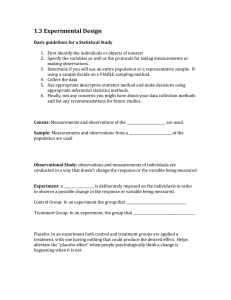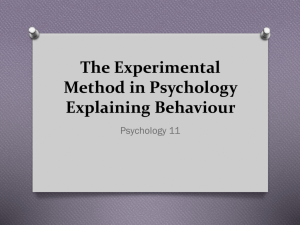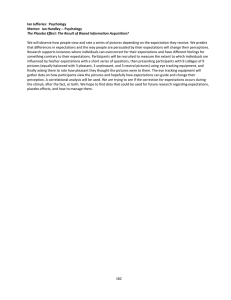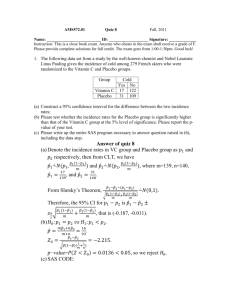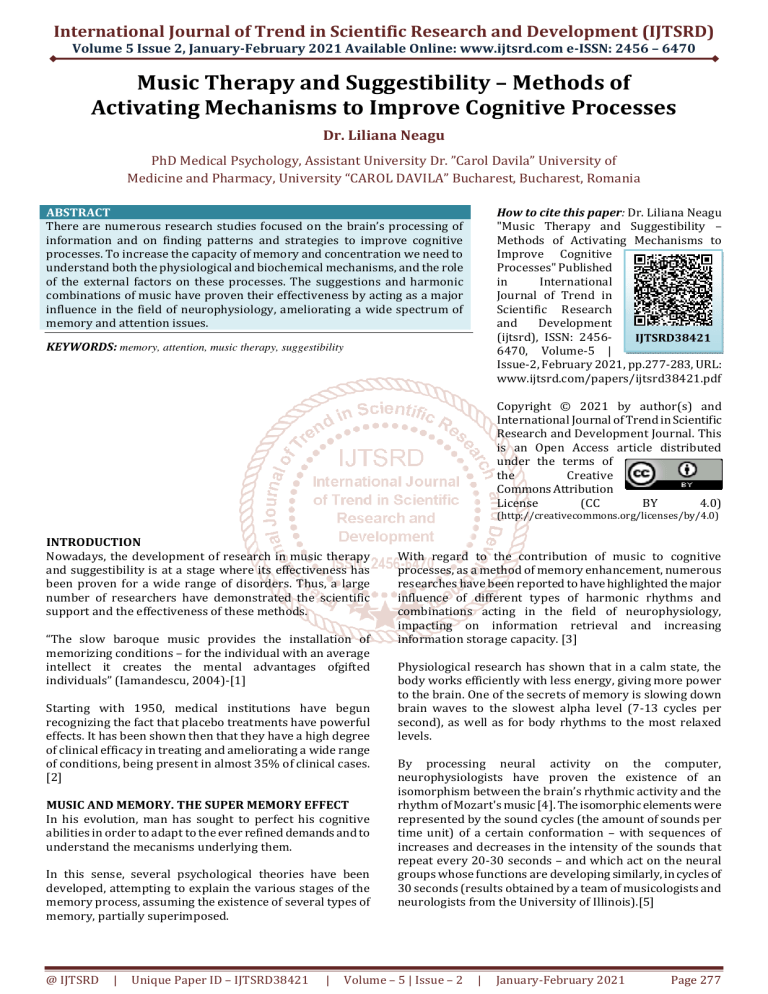
International Journal of Trend in Scientific Research and Development (IJTSRD)
Volume 5 Issue 2, January-February 2021 Available Online: www.ijtsrd.com e-ISSN: 2456 – 6470
Music Therapy and Suggestibility – Methods of
Activating Mechanisms to Improve Cognitive Processes
Dr. Liliana Neagu
PhD Medical Psychology, Assistant University Dr. ”Carol Davila” University of
Medicine and Pharmacy, University “CAROL DAVILA” Bucharest, Bucharest, Romania
ABSTRACT
There are numerous research studies focused on the brain’s processing of
information and on finding patterns and strategies to improve cognitive
processes. To increase the capacity of memory and concentration we need to
understand both the physiological and biochemical mechanisms, and the role
of the external factors on these processes. The suggestions and harmonic
combinations of music have proven their effectiveness by acting as a major
influence in the field of neurophysiology, ameliorating a wide spectrum of
memory and attention issues.
How to cite this paper: Dr. Liliana Neagu
"Music Therapy and Suggestibility –
Methods of Activating Mechanisms to
Improve Cognitive
Processes" Published
in
International
Journal of Trend in
Scientific Research
and
Development
(ijtsrd), ISSN: 2456IJTSRD38421
6470, Volume-5 |
Issue-2, February 2021, pp.277-283, URL:
www.ijtsrd.com/papers/ijtsrd38421.pdf
KEYWORDS: memory, attention, music therapy, suggestibility
Copyright © 2021 by author(s) and
International Journal of Trend in Scientific
Research and Development Journal. This
is an Open Access article distributed
under the terms of
the
Creative
Commons Attribution
License
(CC
BY
4.0)
(http://creativecommons.org/licenses/by/4.0)
INTRODUCTION
Nowadays, the development of research in music therapy
and suggestibility is at a stage where its effectiveness has
been proven for a wide range of disorders. Thus, a large
number of researchers have demonstrated the scientific
support and the effectiveness of these methods.
“The slow baroque music provides the installation of
memorizing conditions – for the individual with an average
intellect it creates the mental advantages ofgifted
individuals” (Iamandescu, 2004)-[1]
Starting with 1950, medical institutions have begun
recognizing the fact that placebo treatments have powerful
effects. It has been shown then that they have a high degree
of clinical efficacy in treating and ameliorating a wide range
of conditions, being present in almost 35% of clinical cases.
[2]
MUSIC AND MEMORY. THE SUPER MEMORY EFFECT
In his evolution, man has sought to perfect his cognitive
abilities in order to adapt to the ever refined demands and to
understand the mecanisms underlying them.
In this sense, several psychological theories have been
developed, attempting to explain the various stages of the
memory process, assuming the existence of several types of
memory, partially superimposed.
@ IJTSRD
|
Unique Paper ID – IJTSRD38421
|
With regard to the contribution of music to cognitive
processes, as a method of memory enhancement, numerous
researches have been reported to have highlighted the major
influence of different types of harmonic rhythms and
combinations acting in the field of neurophysiology,
impacting on information retrieval and increasing
information storage capacity. [3]
Physiological research has shown that in a calm state, the
body works efficiently with less energy, giving more power
to the brain. One of the secrets of memory is slowing down
brain waves to the slowest alpha level (7-13 cycles per
second), as well as for body rhythms to the most relaxed
levels.
By processing neural activity on the computer,
neurophysiologists have proven the existence of an
isomorphism between the brain’s rhythmic activity and the
rhythm of Mozart's music [4]. The isomorphic elements were
represented by the sound cycles (the amount of sounds per
time unit) of a certain conformation – with sequences of
increases and decreases in the intensity of the sounds that
repeat every 20-30 seconds – and which act on the neural
groups whose functions are developing similarly, in cycles of
30 seconds (results obtained by a team of musicologists and
neurologists from the University of Illinois).[5]
Volume – 5 | Issue – 2
|
January-February 2021
Page 277
International Journal of Trend in Scientific Research and Development (IJTSRD) @ www.ijtsrd.com eISSN: 2456-6470
The use of Mozart's music has proved useful even in the case
of the elderly, suffering of Alzheimer's disease [6]. A team of
musicologists and neurologists from the University of Illinois
believes that the already demonstrated “Mozart effect” , that
improves spatial thinking, is involved.
THE PLACEBO EFFECT
‘The Placebo effect’ consists of the physiological and
psychological manifestations that determine the
improvement of a patient's health condition following the
administration of a drug without pharmacodynamic action.
[7]
The perception, codes and symboles that the brain uses in
processing the internal and external information strongly
determine the placebo effectiveness, form and response.
The thought that a drug is effective can cause the body to
release its natural analgesics, the endorphins. Dr. Dragoş
Popa [8] states that ‘important changes have been observed
in the thalamus, in the anterior cingulate cortex, the
prefrontal cortex and the orbitofrontal cortex. Each of these
areas has its function. Tomas Furmark of the Uppsala
University (Sweden) states that a gene has been linked to the
placebo effect.[9]
For this purpose, I compared the effectiveness of three
different interventions by manipulating the independent
variables represented by: 1. baroque music; 2. rhythmic
music; 3. placebo substances, on dependent variables: 1.
semantic memory; 2. visual memory; 3. contextual memory
(work memory); 4. focused attention; 5. distributed
attention/multitasking/the ability to multitaskboth in
healthy subjects, as well as with depressive subjects.
III.
HYPOTHESES
The hypotheses are the following:
A. Does music therapy have an effect on improving
cognitive processes?
B. Does the placebo effect influence memory and attention?
C. Are there significant differences in healthy population's
outcomes compared to the group of depressive patients?
IV.
RESEARCH METHOD
1. Subjects
In the samples used, there have been 260 healthy subjects
included, divided in four equal groups aged between 17 – 19
years and 260 depressive patients that meet the DSM-IV
criteria for depressive disorder, who achieved a score of at
least 10 points at the HAD-S – Hospital Anxiety and
Depression Scale, aged between 24 - 65 years.
The placebo effect is a dynamic, multi-variable phenomenon,
in which factors such as personality, cognition and
conditioning influence the human body through mechanisms
which are still not quite clarified. In addition to the
pharmacodynamic actions, the nonspecific effects of
psychopharmacological drugs raise the issue of the
psychological effects that accompany all therapeutic
actions.[10]
2. Tools/materials
For dependent variables the tools used to assess the results
were the following:
Semantic memory has been evaluated using a test that
included words starting with the same letter, from four
different categories –execution time: 10 minutes;
PERSONAL RESEARCH ON THE USE OF COGNITIVE AND
SUGGESTIVE METHODS FOR IMPROVING MEMORY AND
ATTENTION IN HEALTHY SUBJECTS VS DEPRESSIVE
SUBJECTS
Visual memory has been measured using the Ray-Claparedé
test, which includes 30 images– execution time: 10 minutes:
Work (contextual) memory has been assessed using a test
that comprised three different texts, out of which five
questions were asked from each one, marking with one point
the correct answers – time used: 20 minutes;
I.
PROBLEM
There is continuous technological progress and people are
being bombarded with information, images, sounds, and our
brain is becoming more saturated. In this context, more and
more people are beginning to take an interested in their
intellectual abilities and are scared by the poor performance
of their memory. Their concern is justified, because factors
such as: stress, caused by the anguish of tomorrow,
emotional trauma, depression, a series of infectious diseases,
advanced age, etc., lead to memory impairment. Therefore,
scientists are more and more concerned in finding strategies
and techniques of stimulation and active sustenance to serve
in the interest of memory performance.
For this purpose, many self-training guides have been
developed, for solving exercises to train memory.
II.
RESEARCH OBJECTIVE
The objective of the research is to find ways to actively
sustain and improve cognitive and regulatory capacities,
taking into account the efficacy, the effectiveness, the costs
and benefits of using them, on the one hand, and
understanding the mechanisms underlying the activating of
different types of memory and attention, on the other hand.
@ IJTSRD
|
Unique Paper ID – IJTSRD38421
|
Focused attention has been measured using the Toullouse –
Pieron test.
Distributed attention has been measured using the D.A. and
Praga tests.
V.
DESIGN
1. The design used is an experimental one and it includes
the following variables:
A. Independent variables are represented by
interventions involving the use of two different styles of
music, namely baroque music (Vivaldi, Haendel, Bach,
Telemann) vs rhythmic music (Michael Jackson), and
syrup-like placebo substances.
B. Dependent variables are those to which the expected
effect refers, namely: semantic memory, visual
memory, contextual (work) memory, focused
attention, and distributed attention.
2.
Basic concepts about the dependent variables included
in the experiment
Visual memory has a duration of approximately 100 ms,
with unlimited capacity. It is used to extract the physical
features of the stimulus (colors, contour, intensity, etc)
Volume – 5 | Issue – 2
|
January-February 2021
Page 278
International Journal of Trend in Scientific Research and Development (IJTSRD) @ www.ijtsrd.com eISSN: 2456-6470
Accuracy coefficient: reflects the capacity of selection,
orientation, and optimal focus of the psycho-nervous
energy towards an activity;
Mnemonic coefficient: reflects the memory's
operativity which consists of the duration of the
learning period, the durability of the operational scheme
over time.
Semantic memory refers to the memory of meanings,
significances...
Work (contextual) memory is involved in a wide variety of
complex cognitive behaviors, such as understanding,
reasoning, or problem solving.
Focused attention is the function of attention which
ensures the selection and convergent organisation of
operations and actions of behavior adjustement.
Distributed attention is the function of attention that
allows multiple activities to take place at the same time.
The correlated numerical values
Effectiveness coefficient: reflects the speed of
perception and observation processes indicating the
dynamism of nervous processes;
VI.
PROCEDURE
The measuring was made before and after the introduction
of independent variables. Each group was originally given
memory and attention tests, taking into account the features
contained in the monograph mentioned inthe “tools” section.
VII.
DATA ANALYSIS
In order to substantiate the conclusions a sample of 65
subjects was selected for each group.
VIII.
RESULTS
Results of the T test in depressive subjects
Table no.1(meaning of the results)
Baroque music Placebo effect Rhythmic music
Semantic memory
Significant +
Significant +
Significant +
Visual memory
Significant +
Significant +
Significant +
Contextual memory
Significant Insignificant
Significant Eff. c.
Significant +
Significant +
Significant +
Focused attention
Acc. c.
Significant +
Significant +
Significant +
mn. c.
Significant +
Significant +
Significant +
Eff.c.
Insignificant
Insignificant
Insignificant
Distributed attention Acc.c.
Significant +
Insignificant
Significant +
Mn. c.
Significant +
Insignificant
Significant +
Control group
Significant +
Significant +
Significant Significant +
Significant +
Significant +
Significant Significant +
Significant +
Table no. 2 (values of T test )
Baroque music Placebo effect Rhythmic music
3.711
2.345
5.212
7.195
6.386
5.485
(-)2.831
0.049
(-)4.675
4.78
5.809
7.511
3.102
3.702
2.198
3.102
3.213
2.213
(-)1.405
(-)1.987
(-)3.407
3.258
0.563
2.978
3.238
1.531
3.21
Control group
3.795
2.653
(-)3.866
5.835
2.121
2.121
(-)2.966
3.779
3.792
Semantic memory
Visual memory
Contextual memory
Eff.c.
Focused attention
Acc.c.
Mn.c.
Eff.c.
Distributed attention Acc.c.
Mn.c.
Fig. no. 1
@ IJTSRD
|
Unique Paper ID – IJTSRD38421
|
Volume – 5 | Issue – 2
|
January-February 2021
Page 279
International Journal of Trend in Scientific Research and Development (IJTSRD) @ www.ijtsrd.com eISSN: 2456-6470
Results of T test in healthy subjects
Semantic memory
Visual memory
Contextual memory
Eff.c.
Focused attention
Acc.c.
Mn.c.
Eff.c.
Distributed attention Acc.c.
Mn.c.
Table no. 3 (meaning of results)
Baroque music Placebo effect Rhythmic music
Significant +
Significant +
Insignificant
Significant +
Significant +
Insignificant
Significant +
Significant +
Significant +
Significant +
Significant +
Significant +
Significant +
Significant +
Significant +
Significant +
Significant +
Significant +
Significant +
Significant +
Significant +
Significant Significant Significant Insignificant
Insignificant
Insignificant
Control group
Insignificant
Significant Significant +
Significant +
Significant +
Significant +
Significant +
Significant Insignificant
Semantic memory
Visual memory
Contextual memory
Eff.c.
Focused attention
Acc.c.
Mn.c.
Eff.c.
Distributed attention Acc.c.
Mn.c.
Table no. 4 ( values of T test)
Baroque music Placebo effect Rhythmic music
3.934
3.977
0.468
2.004
4.713
0.911
7.345
9.866
6.393
5.532
4.314
8.729
5.243
4.586
4.921
5.243
4.636
4.921
6.176
7.119
3.746
(-)2.932
(-)4.773
(-)3.690
0.056
(-)1.247
(-)0.579
Control group
(-)0.132
(-)2.606
2.563
6.642
4.724
4.724
4.451
(-)4.323
(-)0.891
Fig. no. 2
IX.
DISCUSSIONS
Regarding the placebo effect, the results obtained in
healthy subjects were favorable for almost all components,
while depressive subjects had a decrease in the degree of
influence.
In the specialty literature, it is known that young people are
less responsive and unlike normal people, patients generally
have more suggestibility and therefore a greater
responsiveness to placebo, but the motivation to improve
their cognitive capacities (memory and attention) was
higher for students, given the fact that high-school
graduation exams were approaching. Some of them were
clearly interested in asking even the source of where they
could buy their substance to better memorize before the
@ IJTSRD
|
Unique Paper ID – IJTSRD38421
|
exams. The marked difference of the placebo effect between
depressive subjects as opposed to healthy subjects is
explained by the symptomatology of these patients,
expressed by the lack of hope and interest, anhedonia,
fatigability – making it impossible for the mobilization of an
additional and equitable energy to determine the placebo
efficacy and response.
Regarding the influence of music on mnemonic and
prosexic processes, we can ask the following questions:
Does the sound background modify the material substratum
of memory or that of the electrical activity of the brain when
we memorize or pay attention? Which of these favours
cognitive processes?
Volume – 5 | Issue – 2
|
January-February 2021
Page 280
International Journal of Trend in Scientific Research and Development (IJTSRD) @ www.ijtsrd.com eISSN: 2456-6470
Dr. Aryel Routtenberg [11] was among the first to discover
that electrical stimulation of certain areas of the brain
engages the release of large amounts of neurotransmitters
involved in memory processes. Dr. Capel [12] found that
different forms of the waves trigger the release of different
neurotransmitters. For example, frequencies of 90-111 Hz
produce endorphins, and frequencies of 4 Hz –
catecholamines, which are important in the process of
memory and attention. Research shows that after listening to
high-frequency music for a certain period of time, the mind
harmonizes itself, charging itself with energy, and it
sharpens. Then, the brain starts to emit the signals
corresponding to the rest of the system and ease replaces the
learning difficulty. Mozart's tempo at high frequencies, as a
background for material reading, gives an energy stimulus to
the brain cortex to recharge and rebalance the brain and the
body, stimulating the connections between the neurons. The
„Mozart effect” would be explained by the fact that the
rhythm of his music reproduces the cyclical rhythms of brain
cells. Dr. Lozanov [13] found that 60 beats/minute music
increases alpha activity with 6% (associated with relaxation)
and lowers beta activity by 6% (associated with the state of
readiness), creating a collage of baroque music which favors
the conditions for a global improvement of memory.
Transmitting specific frequencies in the brain stimulates it to
produce specific chemicals to restore memory.
The material substratum of memory is not yet elucidated.
Penfield assumed that memories would be located in the
temporal lobe, but this assumption was not accepted. There
is a hypothesis in the case of short-term memory that could
be explained by the existence of „reverberating” circuits:
neuron chains forming a closed circuit. When an excitation
comes from the outside it oscillates for several seconds in
this circle – which would explain the persistence of memory.
There are many such circuits in the hippocampus, and the
lesions caused in this region generate serious disorders of
the memory. Eccles argues another hypothesis that repeated
neuron excitation leads to the emergence of new contact
points, either with the dendrites or with the body of another
cell, which would facilitate the circulation of the nervous
influx and implicitly the possibilities of remembrance. It is
certain that there are no special areas for memory and there
are multiple and unlimited possibilities of engraming.
X.
CONCLUSIONS
A. For healthy subjects all processes have a degree of
influence, with significant values for almost all components.
Compared to the control group (without music therapy and
placebo substances), the three forms of psychotherapeutic
intervention had the following effects:
1. Baroque music (creations of Bach, Haendel, Vivaldi,
Telemann) has statistically improved the performance of
subjects in semantic memory tests in Significant mode, –
being on the first position (it increases the power of
evoking), in visual and work memory, as well as focused
attention – the influence being average, but significant, and
distributive attention (the effectiveness coefficient and less
the mnemonic one).
It can be concluded that baroque music has a homogeneous
influence on the types of memory and attention, confirming
the data from the literature that referred to the performance
@ IJTSRD
|
Unique Paper ID – IJTSRD38421
|
of the memory in general without diferentiating them.
Semantic memory, linked to the complex processes of
reasoning, registered the highest score against the other
methods, justifying the hope that baroque music, used as a
background sound during study favors long lasting
mnemonic engraming and an easy updating of the data.
2. Rhythmic music (Michael Jackson's repertoire)
improves focused attention for the three coefficients –
especially the coefficient of effectiveness, which obtained the
best score. This highlights increased possibilities of constant,
voluntary orientation, channeling and focusing of the nerve
energy. It can be said that rhythmic music determines a welladapted and controlled effectiveness, committed voluntary
effort, developed psychomotor skills, good calibration ability
between what the task demands to do. During the hearing,
subjects performed the tasks more quickly and correctly. In
terms of semantic and visual memory, rhythmic music has
not achieved significant values, as well as distributed
attention, being a mild inhibitor of these forms of memory,
compared to baroque music and the placebo effect that have
achieved a superior effect increase.
3. The placebo effect was the surprise of the study by its
particular influences on contextual memory (increasing the
power of recording), especially – obtaining the highest
values on the difference between the average rates and the
other forms (visual and semantic) and – quite a lot – on
focused attention (the accuracy and mnemonic coefficient).
For the distributed attention, the effectiveness coefficient is
the highest, but there is a decreased precision, clarity of
perception – the accuracy coefficient, characteristic of a
mobile nervous system, dominating the process of excitation
which determines a less stable keeping of orientation and
channeling of the nerve energy. It is worth mentioning the
fact that the placebo effect can be invoked in the case of its
favorable influence, in percentages exceeding 30-35%, this
possibility being signaled back in 1967, by Janke (quot.
Iamandescu, 1997), the author estimating that a
doctor/psychologist, with a high therapeutic prestige can
induce a placebo effect in 80% of his patients. Nevertheless,
these suppositions can not shade the favorable role of music
in stimulating the mnezico-prosexic capacity.
4. In the control group there is a decrease of the
differences between the averages, some being significantly
negative, others positive, but compared to the other
interventions, the results are weaker, which may mean that
simply repeating the questionnaires without a sound
stimulus or suggesting an increase in performance after the
administration of a placebo substance does not have the
same effect, a certain lack of interest in performing tasks
emerging, which can be interpreted as a weak resilience to
monotony. Thus, we can say that in the course of a
monotonous unilateral activity, the mobilizing processes are
estinguished. Therefore, a complementary stimulus can
disinhibit them, favoring attention and memory.
B. Depressive subjects have heterogeneous reactions to
the influence of independent variables, compared to healthy
subjects who had homogeneous results, this aspect being
related to their mental dynamics, explained by the
polymorphism of psyhcological mechanisms prevailing in
this patients and the intensity of depression, illustrated by:
Volume – 5 | Issue – 2
|
January-February 2021
Page 281
International Journal of Trend in Scientific Research and Development (IJTSRD) @ www.ijtsrd.com eISSN: 2456-6470
diminished interest, reduced emotional tonus, fatigability,
bradykinesia, bradypsychia, etc.
1. Baroque music particularly influences visual memory
obtaining the highest difference of the average rates and
semantic memory – to a lesser degree, and in focused
attention the scores of the coefficients are homogeneous, but
compared to other methods the accuracy and the mnemonic
coefficient of focused attention is higher, indicating an
optimal alternation of inspection-exploration operations.
2. Rhythic music has favorably influenced semantic
memory and focused attention – the effectiveness coefficient
obtaining the highest score, but other coefficients recorded
small differences – the speed of perception increases, but
precision and clarity are superficial. Distributed attention
records a decrease of the effectiveness coefficient and an
increase of the other coefficients. This highlights that
hyperprosexic polarization to a particular domain is
associated with hypoprosexia for the rest of the domains. It
would be a decrease in commutativity with an increase of
concentration or the opposite way.
3. The placebo effect records significant results in visual
memory, but does not generate significant improvements
compared to the control group. It does not have an impact on
the overall community, as there are big changes in each
individual, especially women obtaining significant positive
differences. For work memory (contextual) negative
significant results have been recorded, both in the case of
listening to baroque music and rhythmic music, some of the
subjects being disturbed by the sound stimuli, highly
disturbing for them when they had to memorize (record) a
text, expressing their wish to work quietly. However,
compared to the other methods and compared to the control
group, where results were negative at the second test, the
placebo effect managed to obtain a constant score on the
work memory, albeit insignificant from a statistical point of
view.
This research confirms the data in the literature, both in
terms of music therapy and the placebo effect, being
performed according to the EBM requirements, through a
rigorous process of evaluation and objective data recording.
In conclusion, after an overall evaluation, taking into account
the results that had the most powerful effect, we can state
that:
1. At the fisrt hypothesis the answer is affirmative,
statistically validated, both for baroque music, which has
proven its superiority through its action on improving
semantic memory (healthy subjects) and visual memory
(depressive subjects) – placing on the first positions, some of
the secrets of music being the power to slow down
brainwaves to the α level, and also for rhythmic music,
improving focused attention (healthy and depressive
subjects), the tasks being performed faster and more
accurately under the influence of this music that determines
the brain to resonate on β waves.
2. The placebo effect activates almost all components in
healthy subjects, especially in the case of work memory, with
the exception of depressive subjects, where there is a large
@ IJTSRD
|
Unique Paper ID – IJTSRD38421
|
dissemination of answers from an individual to another,
determined by the polymorphism of mental disorders
present in these patients.
3. Results revealed in healthy subjects that the placebo
effect increased distributed attention, more exactly the
effectiveness coefficient (involving the posterior cingulate
cortex and the reticular formation of the middle brain), and
in depressive subjects rhythmic music increased focused
attention (involving the anterior cingulate cortex). Also, in
healthy subjects, distributed attention records high values in
the effectiveness coefficient and low values in other
coefficients – the process of excitation prevales
characteristic to a mobile nervous system, but unbalanced,
with difficulties in channeling and focusing the nerve energy,
which may also indicate some superficiality or a lack of
interest in performing the tasks, regardless of the method
used, and in depressive subjects the effectiveness coefficient
of distributed attention is low compared to the other
coefficients (accuracy and mnemonic), meaning that in their
case, a type of inertial nervous system and major difficulties in
forming a perceptual strategy predominates, indicating
difficulties in overcoming the state of emotional inhibition.
There is a significant difference of the placebo effect in
depressive subjects compared to healthy subjects (who
obtained significant differences in almost all components)
which are explained by the characteristics of
symptomatology illustrated by lack of hope and interest,
negative expectations, anhedonia, likely to generate reduced
chances of producing the placebo effect.
As a general appreciation, the results obtained reveal the
beneficial role of music therapy and the placebo effect in
cognitive processes (especially memory and attention). The
examples presented, we hope to incite both to an extension
of the indications of these therapeutic methods, and to the
research of new possibilities of application and refinement of
the observations regarding the brain's responses to external
influences.
SELECTIVE BIBLIOGRAPHY
[1] Capel, P., apud Iamandescu, I.B., Psihologie medicală,
Partea I – Psihosomatica generală, Ed. Infomedica,
Bucureşti, 2008, cap.IX, pp. 297 – 311;[12]
[2]
Croisile, B. et al., Memoria Noastră/Larousse; trad. şi
adapt. Calangiu, A., Enciclopedia RAO, Bucureşti,
2006; [10]
[3]
Furmark, T., sursa internet: http://www.referate.com
(accesat nov. 2018);[9]
[4]
Iamandescu, I.B., Către o muzicoterapie formativă, Ed.
Infomedica, Bucureşti, 2004, 3(121):38-41; [3]
[5]
Iamandescu, I.B., Muzicoterapia receptivă – premise
psihologice şi neurofiziologice, aplicaţii profilactive şi
terapeutice, Ed. Infomedica, Bucureşti, 2004; [1]
[6]
Ionescu, G., Tratat de Psihologie Medicală şi
Psihoterapie, Ed. Asklepios, Bucureşti, 1995, cap. VII,
pp. 195-196;[2]
[7]
Lozanov, G., apud Luban – Plozza. B., Pozzi, U. şi
Carlevaro T., Convivere con lo stress, 1990, Ed.
Românească “Viaţa alături de stres”, 1997;[13]
Volume – 5 | Issue – 2
|
January-February 2021
Page 282
International Journal of Trend in Scientific Research and Development (IJTSRD) @ www.ijtsrd.com eISSN: 2456-6470
[8]
Luban-Plozza, B., Iamandescu, I.B., Dimensiunile
psihologice ale muzicii. Introducere in muzicoterapie.
Romcartexim, Bucuresti, 1997[4]
[9]
Penfield, W., şi Perot, P., The brainʼs record ot visual
and auditory experience: Afinal Summary and
discussion, 1963, Brain 86: 595 – 696;[6]
[10]
Popa, D., apud Iamandescu, I.B., Manual de psihologie
medicală, Ed. Infomedica, Bucureşti, 2010; [8]
@ IJTSRD
|
Unique Paper ID – IJTSRD38421
|
[11]
Pritbram, K., Broadbent,D, Biologie de memorie,
Academic Press, New York, 1970;[7]
[12]
Routtenberg, A., apud Iamandescu, I.B., Muzica –
element terapeutic antistress. Al VII-lea Simpozion
Naţional de Psihoneuroendocrinologie, Poiana
Braşov, 1997; [11]
[13]
Sacks, O., (trad. Bărbulescu, A.), Muzicofilia – povestiri
despre muzică şi creier, Ed. Humanitas, Bucureşti,
2009;[5]
Volume – 5 | Issue – 2
|
January-February 2021
Page 283


